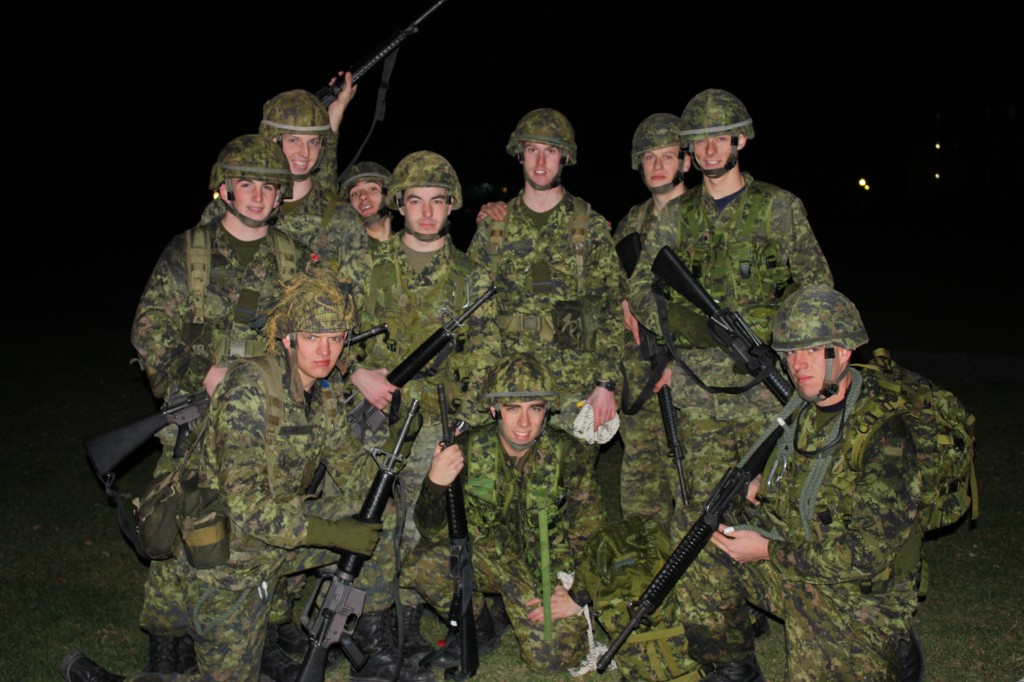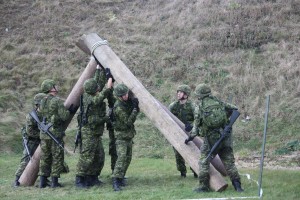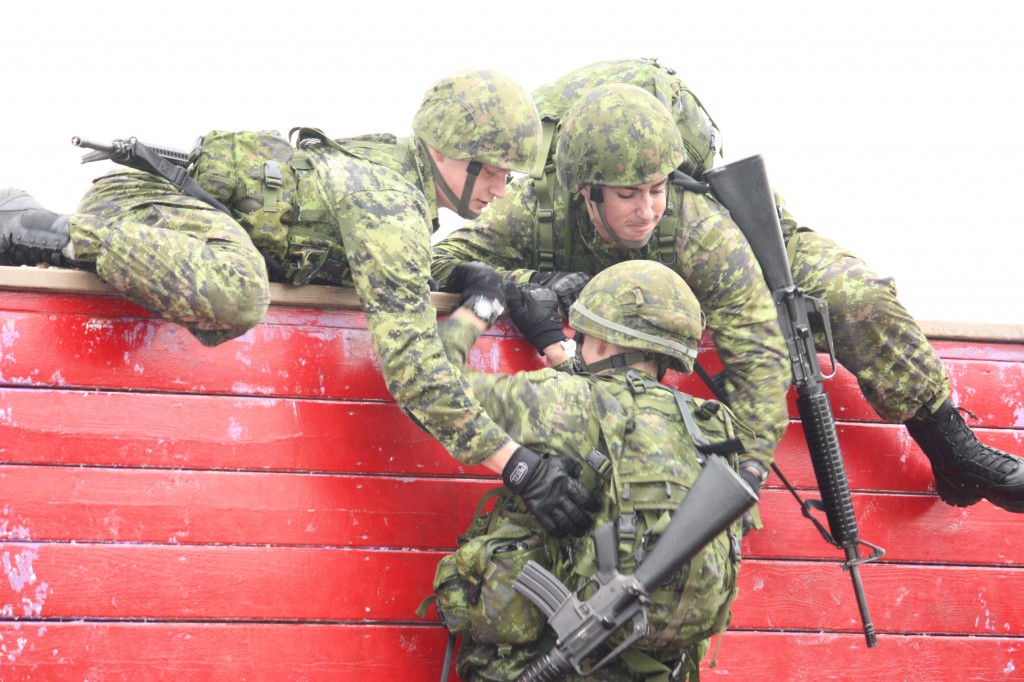
Putting Military Back in the Royal Military College of Canada
Article by 25246, OCdt (IV) Reinthaler
For the past three years the RMCC Sandhurst team has led the Sandhurst intra-mural (IM) program during the fall semester as an introduction to the Sandhurst military skills competition for officer cadets. During the fall IM season each division fields a team of cadets that are selected through a string of tryouts led by veteran RMCC Sandhurst members in early October. Once selection is complete team practices are held every Tuesday and Thursday afternoon immediately after classes. The intent is to mould the teams into cohesive groups with the basic military skills required to complete the RMCC IM Sandhurst competition held in mid-November. This year the IM Sandhurst program appeared the same as compared to previous years, or so I and the other cadets thought. We were wrong: very, very wrong. This year’s RMCC IM Sandhurst competition was one of the toughest and most challenging competitions that I, and the majority of the other participants brave enough to attempt it, have ever faced.
Selections for the Sandhurst IMs teams were held on the Monday immediately following Reunion Weekend. That day, any sane person would have been questioning why RMC’s Inner Field was packed with eager young cadets awaiting to test their metal in a highly demanding and surprising selection process. It is important to note that a mere two days prior many of these cadets had just finished the five weeks of intense training that make up FYOP. The selection process started with a count of the candidates’ maximum push-ups, sit-ups, and pull ups. Each exercise immediately followed the other. We were then told to run up to Fort Henry where we received our next set of instructions. During the whole period we were being hassled by the ever-pleasant support staff who shouted such things as: “you’re going the wrong way,” “run faster,” or “you’re not trying hard enough.” At each station along the way we were given our task and our following destination, there was no mention of how many tasks we would have to complete or how many stations there would be along the way. Finally after over an hour the candidates had run around most of the campus, most likely questioning themselves about what they were getting into, completed squats and push-ups until their limbs felt like they would fall off, carried tires up seven flights of stairs, and wished that they had trained harder and rested more over the weekend. Regardless of how we felt after the tryouts, the Sandhurst veterans liked what they saw and selected their teams accordingly.
The day after tryouts training started immediately for those who had made the four divisional teams. Training over the next several weeks included circuit training, basic military skills training, and pushing personal limits with the ever-cheery motivation of fellow team members and team captains. The circuit training consisted of various exercises such as flipping tractor tires, push ups, sit ups, running, hill sprints (up hills that were originally designed to deter potential attackers) and of course everyone’s favourite: burpees. For the basic military skills component we learnt and practiced first aid, knot tying, wall climbing, constructing rope bridges, and proficiency with the C7 assault rifle. Practices were long and hard, and at many times they seemed to take the fun out of IMs as we could have been playing ball hockey, dodge ball, or water polo.
Persevering in adverse conditions became critical once we learnt that the IM Sandhurst competition was going to be held the Sunday immediately following the annual RMCC Christmas Ball. Much to our dismay the decision was final and there was nothing we could do but soldier on. In addition CMR St-Jean was sending two teams who denied the invite to the Christmas Ball. Going into the competition we had no idea how long it was going to be or how many obstacles we were going to have to complete. Many of the cadets had guessed that the competition was going to be tough, but that it would not take much longer than an hour and a half. Once again we were wrong. The competition area of operations extended from the Point Frederick on the RMC campus to the CFB Kingston base hospital and the 600m range. The fastest time to complete it was 4 hours 15 minutes and 20 seconds. The competition included ten stands, which tested fitness, mental agility, teamwork, and leadership. Each stand was designed to test different skills and together to test the overall preparation and performance of the teams.
Each of the obstacles was a challenge in itself, but lessons were learnt throughout; every obstacle was directly applicable to the profession of arms because they all required planning, competence, and teamwork. Whether it involved rolling a tractor tire down a hill to knock over a tripod made from PT logs or providing first aid to wounded insurgents each stand had the competitors pushing their limits, putting their training into practice, and giving 110%.
Overall the competition hammered home the importance of training and preparation and showed us how far we can push ourselves. Going into the competition we did not know how long it was going to be, how many obstacles we would have to complete, or in what order they would be completed in. During the competition, many of us found ourselves wondering if the pain was ever going to end. Several competitors began to run out of energy and ran on fumes. Some ran through their injuries, others through the knowledge that they should be working on assignments with looming due dates, but we all pushed through. Everybody learnt to find that little switch in the back of their minds that says “quit” and turned it off. We all learnt the value of preparing for the worst and hoping for the best.
Finally, special thanks to all the team captains who made us push ourselves during training because if we had not, we would not have made it through the competition. Even greater thanks are due to all the support staff who organized and supported the training as well as the actual competition by volunteering their time. If not for you, this competition would not have happened and those cadets who ran it would not have learned the lessons that will benefit them as officers. Also, we cannot forget the Christmas Ball dates of those who ran and helped with the competition; thanks for putting up with the early morning wakeup and cheering everybody on.
The results and sub-competition categories:
Overall winner, based on total penalties and time bonuses with all factors considered.
1) RMC D, 4:30:29
2) CMR 2, 4:59:09
3) RMC B, 5:08:13
4) RMC C, 5:15:57
5) CMR 1, 6:39:46
6) RMC A, 6:54:56
Fastest Team, based purely on running time from start to finish.
1) RMC B, 4:15:20
2) RMC A, 4:24:00
3) RMC C, 4:46:03
4) RMC D, 4:53:30
5) CMR 2, 5:05:02
6) CMR 1, 5:51:42
Smartest Team, based on total time bonus from the memory questions at the finish line stand.
1) RMC C, 14min
2) RMC B, 11min30sec
3) CMR 2, 9min
4) RMC A, 8min30 sec
5) RMC D, 8min
6) CMR 1, 7min
Wall Champions, based on time to get the entire team and equipment over the wall.
1) RMC A, 3min59sec
2) CMR 1, 4min42sec
3) CMR 2, 5min54sec
4) RMC B, 5min56sec
5) RMC D, 6min06sec
6) RMC C, 7min59sec
Best Shooters, based on the combined time of the six best shooters on each team.
1) RMC D, 13min38sec (bonus)
2) RMC A, 12min09sec
3) RMC C, 8min48sec
4) RMC B, 5min58sec
5) CMR 2, 4min54sec
6) CMR 1, 22sec
Commandant’s Challenge, based on total time to push the truck the length of the circuit.
1) RMC B, 6min58sec
2) CMR 2, 7min08sec
3) RMC C, 7min52sec
4) CMR 1, 8min29sec
5) RMC A, 10min15sec
6) RMC D, 11min10sec






